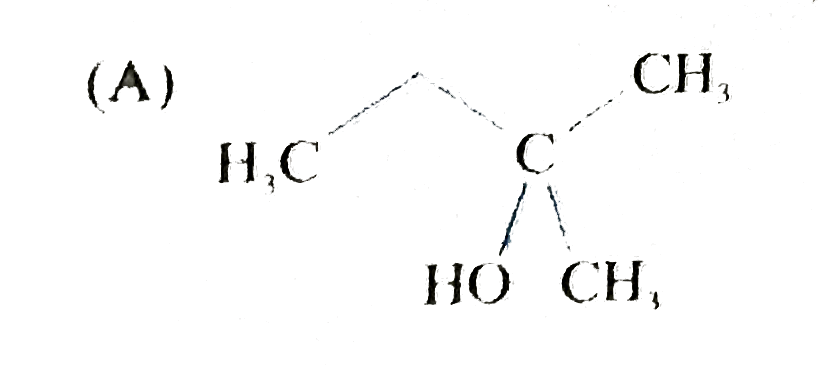Addition of mercuric acetate in the presence of water is called as oxymercuration.The adduct obtained gives alcohol on reduction with NaBH4 in alkaline medium.This is known as demercuration.Oxymercuration demercuration allows Markownikoff's addition of H, OH without rearrangement.The net result is the addition of H2O Answer the following question :

Product 'A'is :




The correct Answer is:A
Topper's Solved these Questions
Similar Questions
Addition of mercuric acetate in the presence of water is called as oxymercuration.The adduct obtained gives alcohol on reduction with NaBH4 in alkaline medium.This is known as demercuration.Oxymercuration demercuration allows Markownikoff's addition of H, OH without rearrangement.The net result is the addition of H2O Answer the following question :
CH3−CH3∣C∣CH3−CH=CH2(i)Hg(OAc)2.THF−−−−−−−−−−−−−−−−→(ii)CH3OHNaBH4NaOHAHi(Conc.)−−−−−−→BProduct B is :
View SolutionAddition of mercuric acetate in the presence of water is called as oxymercuration.The adduct obtained gives alcohol on reduction with NaBH4 in alkaline medium.This is known as demercuration.Oxymercuration demercuration allows Markownikoff's addition of H, OH without rearrangement.The net result is the addition of H2O Answer the following question :
CH3−CH3∣C∣CH3−CH=CH2(i)Hg(OAc)2.THF−−−−−−−−−−−−−−−−→(ii)CH3OHNaBH4NaOHAHI(Conc.)−−−−−−−→B
Product B is :
View Solution
Knowledge Check
Demericuration allows markownifoff's addition of H,OH without rearrangement. The net result is the addition of H2O. Answer the following question.
Q. A
A B
B C
C DBoth A and B
DBoth A and BDemericuration allows markownifoff's addition of H,OH without rearrangement. The net result is the addition of H2O. Answer the following question.
Q.
The product 'C' formation from B occurs throughAenol formationBSN1 mechanismCNeighboring group participationDSNAr mechanismAcid catalysed hydration of alkene give alcohol. In thic reaction addition of water takes place according to Markownikov's rule. Since intermediate carbocation is formed in this reaction, rearrangment of carbocation takes place. In oxymercuration-demercuration reaction hydration of alkene takes place according to markownikov's rule. Oxymercuratio-demercuration-dermercuration no rearrangement is possible. in hydroboration-oxidation hydration of alkene takes place according to anti marjownikow's addition. in HBO reaction rearrangement is not possible. both in oxymercuration-demercuation and hydroboration-oxidation, intermediate carbocation are not formed.
Q. The product formed in the following reaction is:
 PruductA
PruductA B
B C
C DH2C∣OH−CH2C∣CH3H−CH3
DH2C∣OH−CH2C∣CH3H−CH3
Addition of water to alkenes in presence of conc. H2SO4 produces alcohol Which rule is followed in this reaction?
View SolutionAddition of water to alkenes in presence of conc. H2SO4 produces alcohol Which rule is followed in this reaction?
View SolutionAcid catalysed hydration of alkene give alcohol. In thic reaction addition of water takes place according to Markownikov's rule. Since intermediate carbocation is formed in this reaction, rearrangment of carbocation takes place. In oxymercuration-demercuration reaction hydration of alkene takes place according to markownikov's rule. Oxymercuratio-demercuration-dermercuration no rearrangement is possible. in hydroboration-oxidation hydration of alkene takes place according to anti marjownikow's addition. in HBO reaction rearrangement is not possible. both in oxymercuration-demercuation and hydroboration-oxidation, intermediate carbocation are not formed.
Q. CH3−C≡C−H(Sia)2HB−−−−−−−→H2O2/OH−A, A is
View SolutionAcid catalysed hydration of alkene give alcohol. In thic reaction addition of water takes place according to Markownikov's rule. Since intermediate carbocation is formed in this reaction, rearrangment of carbocation takes place. In oxymercuration-demercuration reaction hydration of alkene takes place according to markownikov's rule. Oxymercuratio-demercuration-dermercuration no rearrangement is possible. in hydroboration-oxidation hydration of alkene takes place according to anti marjownikow's addition. in HBO reaction rearrangement is not possible. both in oxymercuration-demercuation and hydroboration-oxidation, intermediate carbocation are not formed.
Q. The product formed in the following reaction is:
 Pruduct
Pruduct
View SolutionHydrogenation of alkenes and alkynes takes place in presence of certain catalysts. In Sabatier Senderen's reaction, the addition of hydrogen takes place I presence of Raney nickel catalyst. Platininm and palladium can also be used as catalyst and used in finley divided state. Experimentally, it is observed that less crowded alkenes adsorb H2 with faster rate. Controlled hydrogenation of alkyne H2 with faster rate. Controlled hydrogenation of alkyne in presence of Lindlar's catalyst yields cis product i.e., 'cis' alkene. Thus, in presence of Lindlar's catalyst 'syn' addition takes place. The relative rate of hydrogenation follows the order:

Non-terminal alkynes are reduced in presence of Na or Li metal dissolved in liquid ammonia. In this reaction, anti-addition of hydrogen results into the trans-product.
Answer the following questions:
The relative rate of catalytic hydrogenation of following alkenes is:

View Solution

